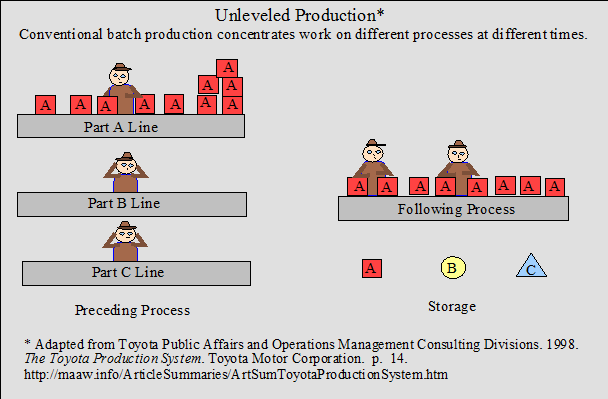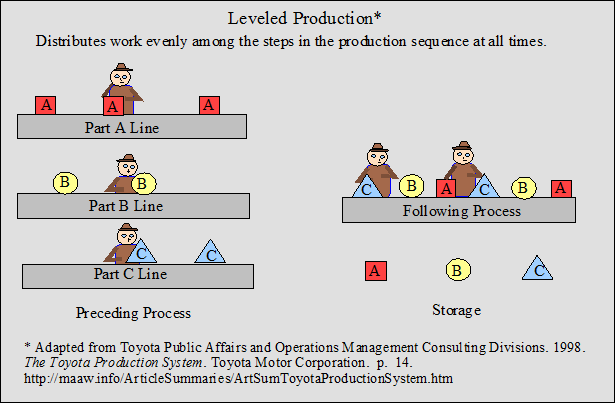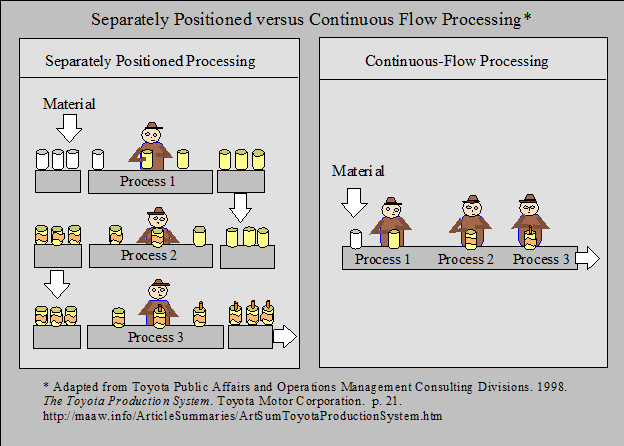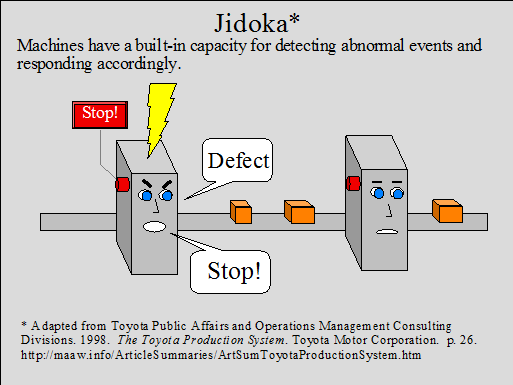
Study Guide by James R. Martin, Ph.D., CMA
Professor Emeritus, University of South Florida
JIT and Lean Enterprise Main Page |
Japanese Management and Accounting Main
Foreword p. v
This is a booklet, not a how-to manual that has been printed several times since it was first introduced in 1992. Although it has been revised extensively since 1995, the essential elements of the Toyota Production System are unchanging. The new (Green) cover emphasizes the role of the system in safeguarding the environment. Manufacturers need to prevent pollution and other damage to the environment, and to conserve resources by using them efficiently. The Toyota Production System provides a framework for conserving resources, eliminating waste, making work fulfilling, putting employees in charge of their work, encouraging creativity, benefiting suppliers, and producing lasting gains in productivity and quality to companies that unite management and employees in a commitment to positive change.
Introduction p. 1
Productivity
Eliminating Waste - The Toyota Production System improves productivity by eliminating waste in how the company uses human resources, equipment, and material in the delivery of what the customer wants, when the customer wants it, and only the quantity the customer wants. Eliminating waste also improves quality and reduces costs by preventing defects.
Roots - The Toyota Production System evolved from the manufacturing system developed by Henry Ford. Prior to the development of Ford's system, automobiles were built in craft shops. Ford broke down the assembly process into simple tasks adding a division of labor, sequenced the tasks along a conveyor belt (production line) that was supported by an integrated supply chain.
New Twists - Since production volumes in postwar Japan were significantly smaller than those in the West, Toyota developed flexible methods to adapt their machines to produce different vehicle models to avoid excess inventory. Toyota also developed mutual trust between labor and management that allowed the company to delegate authority to the multiskilled workers who run the Toyota Production System.
A Biographical Perspective p. 5
Sakichi Toyoda, Kiichiro Toyoda, and Taiichi Ohno were the three most prominent individuals in the development of the Toyota Production System. Sakichi Toyoda invented a loom in 1902 that automatically stopped when there was a problem with the threads. This lead to Toyota's practice of designing equipment to stop automatically to call attention to a problem that arises in the production system. Several years later, Sakichi's son Kiichiro studied Henry Ford's conveyor system and adapted it to produce small quantities of items only when they were needed by the next process. This laid the groundwork for just-in-time production. In fact, Kiichiro Toyoda coined the term "just-in-time." Taiichi Ohno came to the U.S. in 1956 to study automobile plants, but his most important discovery was the supermarket. This lead Ohno to develop production lines on a supermarket self-service basis where the following line (downstream) chooses items only as needed, and the preceding line (upstream) only produces replacement items for the items chosen. This development lead to the pull system and the supporting tool referred to as the kanban, or instruction card system.
Putting the System to Work p. 7
The Toyota Production System can be used by a variety of companies including service oriented organizations. However, to benefit from the system, a company must satisfy three conditions:
1. There must be a strong visible commitment to the system from top management who must participate in the system's implementation and instruct middle-level managers to do likewise.
2. All employees must participate in the system. Full participation is essential to establish a smooth, continuous flow through the entire production sequence.
3. The company must develop a framework for cultivating leaders and providing employees with the necessary skills. This will allow teams of multiskilled employees to design standardized work procedures for their own jobs, continuously improve those procedures, and to stop the production line when a problem is detected.
The benefits expand as companies work together to develop a smooth flow from suppliers to the assemblers of finished goods to the dealers who sell the products to customers. Each process becomes the customer for the proceeding process, and each process becomes the supermarket to the following process.
Part I: Just-in-Time Production p. 11
Doing It All for the Customer
Assembly plants make vehicles only in response to actual dealer orders. "Just-in-time production means making only what is needed, only when it is needed, and only in the amount that is needed." This eliminates the need for managing large inventories of parts and products that create wasteful financing, moving, and storage costs, and in some cases obsolescence costs resulting from changes in specifications. Mastering the concept of just-in-time enables managers and employees to distribute the production of different items evenly through the day and week to level production, link each process to the preceding process to support a pull system, make items one at a time to support a continuous flow, and link the pace of work (takt time) in every process to the pace of sales.
Leveled Production p. 13
Just-in-time production requires distributing work evenly by leveling production. Toyota's dealers provide information about expected sales on a monthly basis, and information about actual orders every 10 days. Daily production plans are based on this information, including the exact sequence of items to produce. Different items are distributed evenly among the steps in the assembly processes over the day to ensure using a minimum of manpower and equipment.


Running a Pull System p.15
In push manufacturing systems, companies produce products and push them down stream regardless of the pace of work of the following processes, or customer demand for the parts or products. Parts and semi finished products pile up creating a great deal of wasted time, effort, space, handing, etc. In contrast, a pull system links all production to real demand. Everything in the system only happens to fulfill actual orders.
Toyota uses a tool referred to as a kanban to operate the pull system. Kanban (signboard) are frequently just simple cards that include lettering and bar codes that identify items, worksite locations, and upstream product line, or supplier. Toyota uses parts withdrawal kanban (communication between processes) and production instruction kanban (communication within processes). Withdrawal kanban are taken off parts by operators to be sent back to the proceeding process. Operators deposit the kanban in a kanban mailbox. These kanban are gathered several times a day and placed in collection boxes for the kanban postmen who take them to a sorting room where they are automatically placed in supplier boxes. Production instruction kanban are removed by the following process and sent back to their process as instructions to produce another part. Kanban are used to enforce an organic linkage between work in preceding (upstream) processes and following (downstream) processes with minimal paperwork and maximal efficiency, where employees are completely in charge.
Continuous-Flow Processing p.20
Continuous-flow processing means that the plant is designed so that work proceeds directly from one process to the next process without any detours into storage from raw materials plants, through machining plants, to assembly plants, to distributors, dealers, and customers. One-at-a-time production is ideal, but where that is impractical (e.g., in forging, casting, and stamping processes that require changes in dies, molds, or other tools), Toyota works to shorten changeover times, and uses the smallest batches possible to keep inventories low.
In continuous-flow processing, operators are located next to each other and each operator handles one assembly at a time in a continuous flow. This provides a number of advantages over separately positioned processing where each operator produces a batch of items before they are moved to the next operator. Continuous-flow processing minimizes the lead time between operations, balances the distribution of work, facilitates determining the cause of a defect when it occurs, and minimizes the number of items on the line to equal the number of operators.

Takt Time p. 22
Takt is a German work for meter. In the Toyota production system, takt is the pace of sales in the marketplace, i.e., the pace of actual customer demand. This translates into the following:
Takt = Daily working hours ÷ Number of vehicle orders needed per day
Takt times are calculated for all items. If sales volume increases, takt time is reduced accordingly.
Multiskilled Operators p. 23
The most efficient work flow and procedures are determined based on takt time. Work is allocated to maintain a steady, optimal work load for each operator and each machine with emphasis on quality, safety, quantity, and cost. When demand increases, takt time is reduced, the flow of work is streamlined, and operators are added as needed. Workers master a broad range of skills and multiprocess handling, i.e., operators learn to handle different kinds of machines, e.g., lathe, milling, drilling, and tapping machines. This provides the flexibility in allocating work that enables Toyota to accommodate changes in takt time. When demand increases, takt time is decreased, and each worker performs fewer tasks, e.g., lathe and milling. When demand decreases, takt time is increased, and each worker performs more tasks, e.g., lathe, milling, drilling, tapping.
Part II: Jidoka
Building Quality into the Production Process p. 26
The concept or principle of jidoka can be traced back to Sakichi Toyoda's loom that stopped immediately when a thread snapped. Toyota follows this concept and designs equipment to detect abnormalities and stop automatically when they occur. Production operators also have the means to stop the production flow when they see anything suspicious. This prevents defective items from moving into subsequent stages and the waste that would result from a series of defective items. Stopping the line exactly where an abnormality occurs facilitates identifying the cause of the problem. Since machines stop automatically, operators do not have to watch over each machine as they would on an unautomated line. This humanistic approach (human-machine interface) liberates operators and improves productivity.

Every operator is a quality inspector of his or her own work. When an operator pulls a line-stop cord, the line continues to move to the next fixed position where each process on the line has completed one work cycle. This gives the team leader and operator a chance to fix the problem before the line stops, and avoids the errors and quality problems that tend to occur when there are interruptions in the middle of a work cycle. Andon (automated line) lamps show the numbers of work stations where operators have pulled a line-stop cord, and indicate the status of the work on the line.
Part III: Standardized Work and Kaizen
Standardized Work: The Basis for Kaizen p. 32
Standardized work specifies detailed step-by-step guidelines for every job in the system and includes three elements:
Takt time - the pace of sales in the marketplace.
Working sequence - the most efficient series of steps currently found to perform a task that is continuously improved (kaizen) by team leaders and team members. The working sequence is illustrated in a standardized work chart at the worksite.
Standard in-process stock - the minimum number of workpieces needed in a process to maintain a smooth work flow.
As production volumes change, standardized work must change to accommodate the new production volume.
Kaizen: The Lifeblood of Standardized Work p. 34
Kaizen means continuous improvement. At Toyota, there are two kinds of kaizen activities: equipment kaizen, and work kaizen. As indicated above, standardized work means following the series of steps consistently. When a task is performed in the same way each time, it is much easier to identify problems and correct them in a timely manner. Work kaizen involves modifying the working sequence and is used first when a problem occurs. More difficult and expensive equipment kaizen is used to resolve problems when work kaizen is insufficient.
Part IV: The Continuing Evolution of the Toyota Production System p. 35
The System Is Alive p. 36
The basic goals of the Toyota production system are customer satisfaction and corporate vitality. The scope of the system is expanding to a broader number of industries, as well as upstream and downstream processes within those industries. The tools and techniques of the system are also changing as a result of technological advances and globalization.
Case Study 1: North America p. 37
This case study provides a description of how the Toyota Supplier Support Center in Kentucky worked with Grand Haven Stamped Products Company in Michigan to improve its production process. Grand Haven began by setting up a continuous-flow line in one cell and later extending the continuous-flow into the proceeding process. The company also shortened changeover times, revised work procedures, and streamlined its stamping work by implementing a kanban system. Productivity gains were significant.
Case Study 2: Europe 39
This case study provides a description of how Toyota engineers helped the German manufacturer Brose's U.K. plant implement several improvements in a line that makes window regulators. They introduced the concept of takt time, converted the line to one-at-a-time continuous-flow processing, implemented a kanban system, and reduced the size of their production batches.
Employee Satisfaction as the Key to Customer Satisfaction p. 41
Employee participation, trust, sufficient skills, and fulfilling work leads to employee satisfaction, and employee satisfaction is the key to customer satisfaction. Toyota Employees are multiskilled, and participate in kaizen activities as indicated previously. Recognizing that work is more fulfilling when employee teams can handle all the steps involved in assembling complete systems, Toyota makes an effort to design work in that way.
Hands Across the Sea p. 42
To minimize lead times for plants outside of Japan, Toyota has developed long-distance logistics including: transporting parts in frequent shipments of small lots, and employing mixed loads of various parts from many suppliers to use every cubic inch of space in containers, trucks, and ships.
Beyond Manufacturing p. 43
Just-in-time principles are being applied more thoroughly to dealer parts orders as well as to vehicle orders. Dealers are persuaded only to replace items that they have used. In addition, standardized work is being applied to maintenance and repair shops.
Afterword p. 44
The Toyota production system is clearly more than a production system. Just-in-time principles are being used to increase productivity in a broad range of business and service organizations. The system works because it puts people in charge of their own jobs, and encourages them to find better ways to do their work. To use the system, people must be prepared to abandon old practices. Everyone must get involved and begin by trusting each other. Employees must take responsibility for improving competitiveness through continuous improvement, and management must be willing to share the gains in profitability with employees who generate those increases through gains in productivity. Together, they can work miracles.
_______________________________________
Related summaries:
Baggaley, B. and B. Maskell. 2003. Value stream management for lean companies, Part I. Journal of Cost Management (March/April): 23-27. (Summary).
Baggaley, B. and B. Maskell. 2003. Value stream management for lean companies, Part II. Journal of Cost Management (May/June): 24-30. (Summary).
Davenport, T. H. and J. Glaser. 2002. Just-in-time delivery comes to knowledge management. Harvard Business Review (July): 107-111. (Summary).
Fullerton, R. R. 2003. Performance measurement and reward systems in JIT and non-JIT firms. Cost Management (November/December): 40-47. (Summary).
Fullerton, R. R. and C. S. McWatters. 2002. The role of performance measures and incentive systems in relation to the degree of JIT implementation. Accounting, Organizations and Society 27(8): 711-735. (Summary).
Goodson, R. E. 2002. Read a plant - fast. Harvard Business Review (May): 105-113. (How the rapid plant assessment (RPA) process can tell you if a factory is truly lean in as little as 30 minutes. The process includes two tools: The RPA rating sheet includes 11 categories for assessing leanness, and the RPA questionnaire includes 20 yes or no questions). (Summary).
Imai, M. 1986. Kaizen: The Key To Japan's Competitive Success. New York: McGraw-Hill Publishing Company. (Summary).
Johnson, H. T. and A. Broms. 2000. Profit Beyond Measure: Extraordinary Results through Attention to Work and People. The Free Press. (Summary).
Kalagnanam, S. S. and R. M. Lindsay. 1998. The use of organic models of control in JIT firms: Generalising Woodward's findings to modern manufacturing practices. Accounting, Organizations and Society 24(1): 1-30. (Summary).
Kapanowski, G. 2016. Lean fundamentals for accountants. Cost Management (January/February): 5-14. (Summary).
Maginnis, M. A. and G. Uminger. 2018. Management accounting in a true lean (TPS) environment. Cost Management (January/February): 27-35. (Summary).
Martin, J. R. Not dated. Chapter 8: Just-In-Time, Theory of Constraints, and Activity Based Management Concepts and Techniques. Management Accounting: Concepts, Techniques & Controversial Issues. Management And Accounting Web. Chapter 8
Martin, J. R. Not dated. Lean concepts and terms. Management And Accounting Web. Lean Concepts and Terms Summary
Martin, J. R. Not dated. Profit Beyond Measure graphics and notes. Management And Accounting Web. Johnson Broms Graphics Notes
Martin, J. R., W. K. Schelb, R. C. Snyder, and J. C. Sparling. 1992. Comparing the practices of U.S. and Japanese companies: The implications for management accounting. Journal of Cost Management (Spring): 6-14. (Summary).
Spear, S. and H. K. Bowen. 1999. Decoding the DNA of the Toyota production system. Harvard Business Review (September-October): 97-106. (Summary).
Spear, S. J. 2004. Learning to lead at Toyota. Harvard Business Review (May): 78-86. (Summary).
Staats, B. R. and D. M. Upton. 2011. Lean knowledge work: The "Toyota" principles can also be effective in operations involving judgment and expertise. Harvard Business Review (October): 100-110. (Summary).
Swank, C. K. 2003. The lean service machine. Harvard Business Review (October): 123-129. (Summary).
Womack, J. P. and D. T. Jones. 1994. From lean production to the lean enterprise. Harvard Business Review (March-April): 93-103. (Summary).
Womack, J. P. and D. T. Jones. 1996. Beyond Toyota: How to root out waste and pursue perfection. Harvard Business Review (September-October): 140-144, 146, 148-152, 154, 156, 158. (Summary).